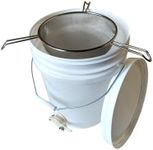Buying Guide for the Best Honey Extractors
Choosing the right honey extractor is crucial for beekeepers who want to efficiently harvest honey from their hives. The right extractor can save time, reduce honey waste, and ensure the honeycomb remains intact for future use. When selecting a honey extractor, consider the size of your operation, the type of frames you use, and how often you plan to extract honey. Understanding the key specifications will help you make an informed decision that best suits your beekeeping needs.Type of ExtractorHoney extractors come in two main types: manual and electric. Manual extractors require physical effort to spin the frames and extract honey, making them suitable for small-scale beekeepers or those who enjoy a hands-on approach. Electric extractors, on the other hand, use a motor to spin the frames, which is ideal for larger operations or those who want to save time and effort. Consider your physical ability, the volume of honey you expect to extract, and your preference for manual versus automated processes when choosing between these types.
CapacityThe capacity of a honey extractor refers to the number of frames it can hold at one time. Extractors typically range from holding 2 to 20 frames. Smaller extractors (2-4 frames) are suitable for hobbyists or small-scale beekeepers, while larger extractors (8-20 frames) are better for commercial operations or those with many hives. Consider the number of hives you have and how often you plan to extract honey to determine the right capacity for your needs.
MaterialHoney extractors are usually made from stainless steel or plastic. Stainless steel is durable, easy to clean, and resistant to rust, making it a popular choice for serious beekeepers. Plastic extractors are lighter and more affordable, which might be suitable for beginners or those with budget constraints. Consider the durability, ease of cleaning, and your long-term beekeeping plans when choosing the material of your extractor.
Frame CompatibilityDifferent extractors are designed to accommodate specific frame sizes, such as deep, medium, or shallow frames. It's important to ensure that the extractor you choose is compatible with the frames you use in your hives. Some extractors offer adjustable baskets to fit various frame sizes, providing more flexibility. Check the frame size compatibility of the extractor to ensure it matches your beekeeping setup.
Ease of Use and CleaningAn extractor that is easy to use and clean can save you a lot of time and effort. Look for features like a clear lid to monitor the extraction process, a stable base to prevent tipping, and a simple mechanism for loading and unloading frames. Additionally, consider how easy it is to disassemble and clean the extractor, as honey can be sticky and difficult to remove. Choose an extractor that balances ease of use with your willingness to spend time on maintenance.

















